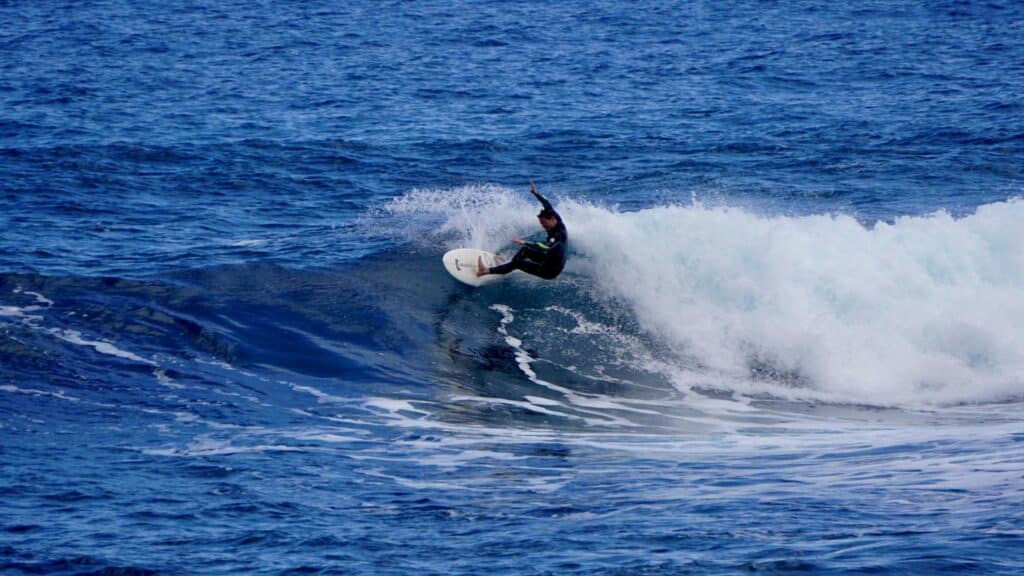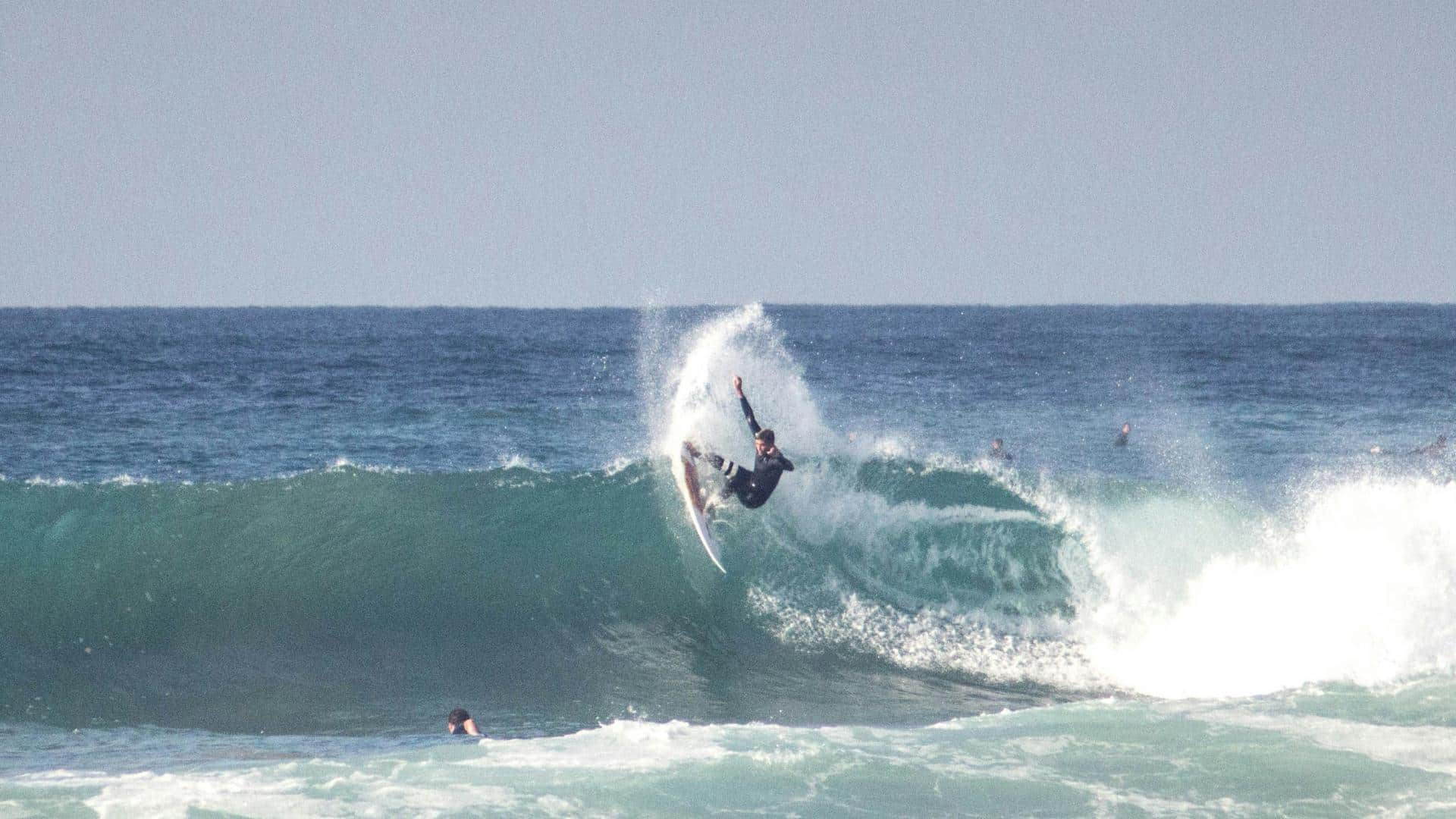In the event you’ve been browsing for some time now and are able to up the ante, studying to grasp the cutback is not only a game-changer; it’s an exciting new frontier in your wave driving journey.
This manoeuvre is a surefire strategy to elevate your rides and assist you keep within the wave’s energy zone, permitting you to keep up velocity but additionally navigate effortlessly again to the wave’s candy spot.
So, on this information, we’ll break down the strategies and suggestions for greedy this trick and reveal just a few of the widespread errors surfers usually make alongside the way in which. By being conscious of those pitfalls, you possibly can keep away from them and progress extra shortly in your browsing journey.
So, hopefully, by the top of this information, you’ll have all the data it’s essential to exit and carry out easy, trendy cutbacks. Whether or not you’re aiming to sharpen your turns or refine your wave positioning, let’s dive in and begin carving up these waves!
What Is a Cutback in Browsing?


A cutback in browsing is a transfer the place the surfer turns the board again towards the wave’s breaking half, often in a easy, arcing movement. It helps the surfer keep within the highly effective a part of the wave (also referred to as the ability supply), permitting for higher management and velocity.
Cutback Browsing vs Lower Browsing
At this level, it’s price clarifying that minimize browsing and cutbacks are associated ideas in browsing, however they check with totally different points of manoeuvring on a wave:
- Lower browsing: This can be a broader time period encompassing any sharp turns or manoeuvres a surfer makes whereas driving a wave.
- Cutbacks: In distinction, a cutback is a particular manoeuvre inside minimize browsing. It includes a surfer driving up the face of the wave after which making a pointy flip again towards the breaking a part of the wave. The purpose of a cutback is to return to the wave’s energy supply (the breaking part), permitting the surfer to regain most velocity and keep momentum.
Now that we’ve coated the fundamentals let’s take a better have a look at various kinds of cutbacks:
Varieties of Cutbacks
Cutbacks might be categorised into three foremost sorts primarily based on the surfer’s orientation to the wave:
- Forehand cutbacks
- Bottom cutbacks
- Roundhouse cutbacks
Every of the above requires totally different strategies and boasts its personal set of distinctive challenges and rewards. With that mentioned, let’s discover every in flip:
The Forehand Cutback
A forehand cutback is a basic surfing manoeuvre the place the surfer adjustments course by turning again towards the breaking a part of the wave. It’s carried out whereas dealing with the wave, therefore the time period “forehand,” which refers back to the surfer’s chest dealing with the wave through the flip.
On this transfer, the surfer rides up the face of the wave, reaches the highest, after which shifts their weight onto their again foot to provoke the flip.
By making use of strain and utilizing their physique’s momentum, they carve the board in an arcing movement again towards the breaking a part of the wave.
The right way to Grasp the Forehand Cutback
As you’ve in all probability already guessed, positioning is essential in sustaining management and maximising energy in a forehand cutback.
As you face the wave through the flip, this orientation means that you can clearly see the wave’s contours and adapt to its altering form.
To execute a profitable forehand cutback, begin by shifting your weight onto your again foot. That is the important thing to initiating the flip.
The again foot acts because the pivot level, enabling you to carve a easy, managed arc again towards the wave’s breaking part.
Preserve your knees bent and your higher physique engaged, along with your main arm pointing within the course of the flip.
This physique positioning not solely helps keep steadiness but additionally generates the mandatory torque for a dynamic cutback.
Keep in mind: The extra strain you apply to your again foot, the sharper and extra responsive your flip might be.
The Bottom Cutback
A unique method is required for the bottom cutback in comparison with the forehand cutback.
As an alternative of dealing with the wave to carry out a bottom cutback, the surfer has their again to the wave. This manoeuvre requires extra steadiness and a distinct weight distribution since you possibly can’t see the wave as clearly, making it more difficult to execute however providing a novel movement and energy as soon as mastered.
The right way to Grasp the Bottom Cutback
The again foot is pivotal in producing energy and management throughout a bottom cutback, so you’ll want to place it correctly:
As you method the breaking wave, resolve the place you’ll provoke the cutback. Ideally, this needs to be close to the highest third of the wave, the place you’ve got sufficient room to finish the manoeuvre.
Then, lean into your again foot and compress your physique as you begin a backside flip. This helps to create the ability wanted to launch into the cutback.
As you attain the highest of the wave, shift your weight onto your again foot. Rotate your shoulders and higher physique in the direction of the wave’s breaking part and maintain your eyes centered on the place you wish to go.
Professional Tip: Your again foot needs to be positioned firmly over the tail pad, with the ball of your foot immediately over the again fin. This lets you apply strain on the rail when initiating the flip and offers you the leverage to pivot the board. As you press down along with your again foot, you interact the fin and tail, permitting you to carve via the flip with extra precision.
Apply strain to your heels whereas concurrently extending your entrance arm throughout your physique. This motion will information your board into the flip.
As you carve again towards the breaking part of the wave, give attention to partaking your board’s rail. Push more durable along with your again foot to dig the rail into the water, sustaining management as you draw the arc of the cutback.
As you attain the breaking part, shift your weight again onto your entrance foot to finish the flip. It will assist you regain your velocity and arrange in your subsequent manoeuvre.
After finishing the cutback, modify your physique place and look down the road to re-engage the wave’s face. Keep low and compressed, able to proceed driving or arrange in your subsequent transfer.
Keep in mind: Whereas your again foot controls the flip, your entrance foot acts as a information, setting the board’s course. It needs to be positioned simply barely ahead of the centre, along with your toes angled towards the nostril. The position of the entrance foot helps keep steadiness and stability as you switch your weight from rail to rail through the flip.
Roundhouse Cutback Mastery
The roundhouse cutback is a complicated wave riding manoeuvre that includes creating an ‘8’ sample on the wave floor. This transfer requires exact timing, superior talent, and wonderful composure.
Surfers carve a large, arcing flip again towards the breaking a part of the wave (the white water) after which transition into one other flip to proceed driving down the road.
The right way to Grasp the Roundhouse Cutback
As you method a piece with an open face, place your self in the course of the wave, aiming towards the shoulder (the unbroken half).
Then, execute a strong backside flip to generate momentum. Bend your knees, interact your rail (fringe of the surfboard), and shift your weight onto your again foot. This will provide you with the ability wanted for the cutback.
As you attain the highest of the wave, start your flip by wanting over your shoulder towards the breaking a part of the wave. That is the place you wish to carry out the cutback.
Shift your weight to your entrance foot, and lean into your toeside rail (when you’re an everyday foot, that is your left rail; for goofy footers, it’s the precise rail) to begin carving again towards the whitewater.
Lengthen your arms and physique, utilizing your entrance arm to information the flip and your again arm for steadiness. The important thing to a correct roundhouse is making a easy, broad arc. Concentrate on utilizing your hips and shoulders to assist pivot the board.
As you attain the whitewater, shift your weight barely again to arrange for the rebound. Your board ought to hit the froth with sufficient velocity and power to bounce off it.
Redirect your board again down the face of the wave. Preserve a low stance, bend your knees, and be able to regain velocity as you head again towards the unbroken a part of the wave.
Frequent Errors and The right way to Keep away from Them
A typical mistake when performing cutbacks is initiating the flip too early on the wave. It will trigger you to lose velocity.
This often occurs when surfers instinctively intention for the shoulder of the wave somewhat than staying nearer to the ability supply within the pocket.
By transferring too far out, they lose the wave’s momentum, making it more durable to regain velocity and keep fluidity. As an alternative, surfers ought to give attention to timing their cutback to remain within the wave’s essential part, permitting them to harness extra energy and keep a smoother, quicker flip. This method not solely preserves velocity but additionally enhances general management and elegance.
Are You Prepared To Carry out Your First Cutback?
If you wish to take your wave driving abilities to the following degree, it’s time to learn to cutback! Whether or not you’re fine-tuning your forehand, bottom, or roundhouse approach, do not forget that follow, endurance, and timing are key.
You’ll end up carving via waves with extra confidence, precision, and elegance as you hone your cutback abilities.Nonetheless, if you need somebody that can assist you nail this manoeuvre, be a part of us at Rapturecamps and expertise epic surf periods {and professional} teaching. Whether or not you’re in Costa Rica, Bali, Morocco, Nicaragua or Portugal, there’s no higher place to trip your greatest waves. Book your surf adventure immediately at Rapturecamps and begin turning your cutbacks into artworks!
